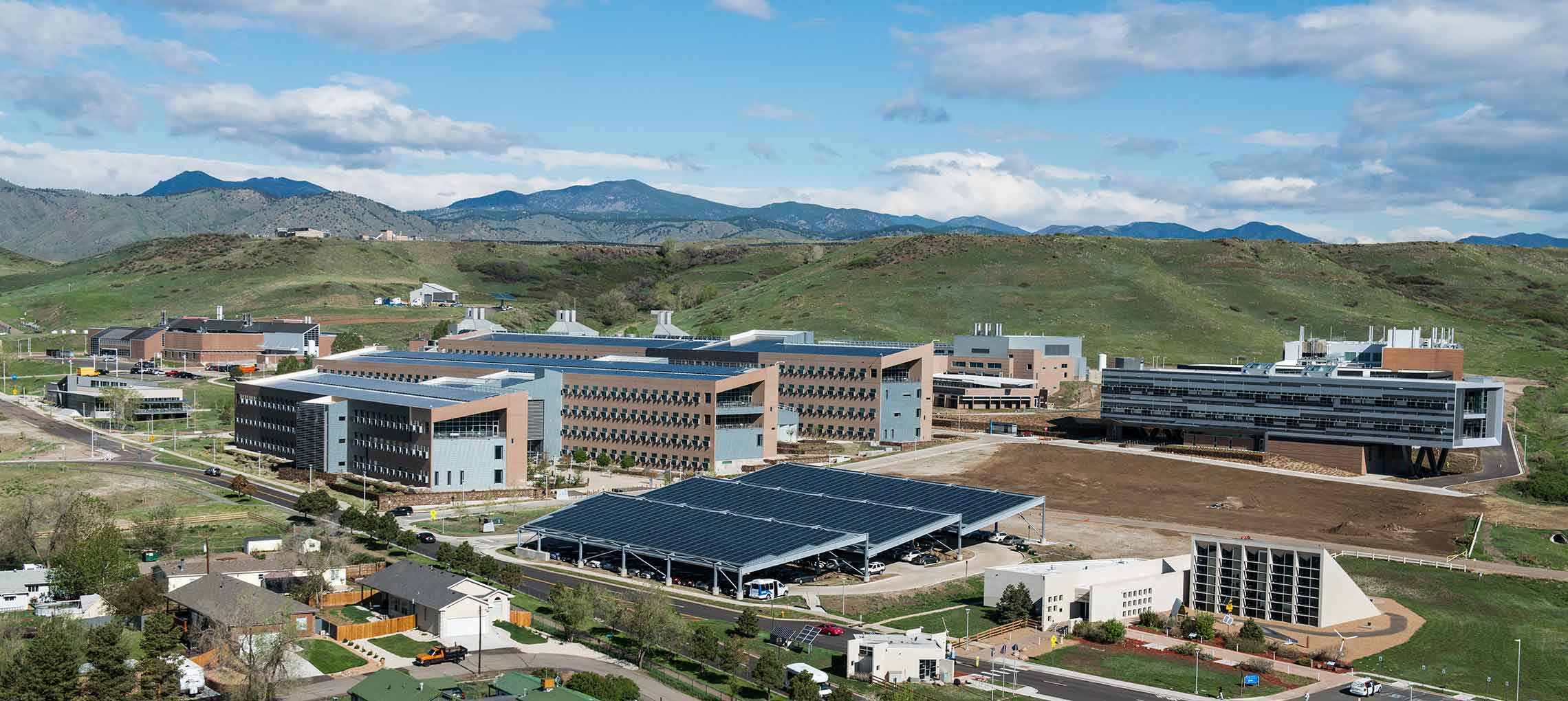The editors of R&D Magazine have named the Energy Department’s Energy Systems Integration Facility (ESIF) as the 2014 Laboratory of the Year. Located on the campus of the National Renewable Energy Laboratory (NREL) in Golden, Colo., research at ESIF transforms how the nation generates, delivers and uses energy by modernizing the interplay between energy sources, infrastructure, and data.
ESIF received this prestigious international award for being a first-of-its-kind research user facility that uniquely merges three very specialized components: an ultra-energy efficient workplace that consumes 74% less energy than the national average for office buildings, one of the world’s most energy efficient high performance computing data centers, and sophisticated high-bay laboratory spaces with outdoor test areas. All of the labs in the 182,500-square-foot building are connected by a research electrical distribution bus (REDB), which functions as a power integration circuit capable of connecting multiple sources of energy with experiments.
“With ESIF, DOE is able to leverage even stronger partnerships with manufacturers and utilities to help integrate renewable energy into a smarter, more resilient energy system,” DOE Assistant Secretary for Energy Efficiency and Renewable Energy David Danielson said.

Only in its first year of operation, strides are being made at ESIF to advance clean energy technologies and grid integration. NREL and its partners are using state-of-the-art capabilities to develop advanced PV inverter technology, high performance computer (HPC) cooling systems, microgrid controls, plug-in electric vehicles, and hybrid power systems.
“We’ve known that industry was eager for a place like ESIF, which allows utility companies and investors to see technology working in real time and on a large scale,” NREL Director Dan Arvizu said. “ESIF continues to demonstrate the importance of partnerships among the national labs, industry, and academia. We have many partners already doing work at ESIF, and many more have expressed interest in helping advance these technologies.”
In 2008, NREL was recognized by R&D Magazine with a special award for the Science & Technology Facility. The 71,000-square-foot laboratory was the first federal building to achieve the highest Leadership in Energy and Environmental Design (LEED) Green Building rating from the U.S. Green Buildings Council and marked the beginning of a series of LEED Platinum high-performance buildings at NREL.
Constructed by the design-build team of SmithGroupJJR and JE Dunn, ESIF became the fifth facility at NREL to earn a LEED platinum designation. Home to 200 scientists and engineers, the multi-story building fits into the sloping side of a mesa and is bounded by an arroyo on one side. Care was taken to minimize disturbing the natural terrain during construction.
ESIF achieved all 56 LEED points applied for, and the facility is 40% more energy efficient than the baseline building built according to ASHRAE/IESNA Standard 90.1-2004. This is an exceptional achievement when considering that the ESIF has a 1 megawatt (MW) AC electric grid simulator, a 1 MW photovoltaic simulator, and a 1 MW load bank connected through the REDB, along with a variety of high and medium voltage outdoor testing areas.
The total cost to build and equip ESIF was $135 million.
“To have the ESIF facility, which advances research capabilities that don’t exist anywhere else in the world, recognized for such a prestigious award only proves the hard work and dedication of the project team,“ states Brad Woodman, AIA, LEED AP BD+C, vice president and director of SmithGroupJJR’s Phoenix office. “Congratulations to the entire ESIF team for a job well done on a project that will change the future of energy thought and use worldwide.”
ESIF’s high performance computing data center is a key factor in the building’s energy efficiency. NREL reuses the “waste” heat generated by the HPC system as the primary heat source in ESIF offices and lab space.
Combining the efficiency of the data center the energy efficiency features of the HPC system and reusing the system’s heat to reduce overall energy use saves approximately $1 million in annual operating costs compared to a traditional data center.
Awards for the Laboratory of the Year will be presented at the 2014 Laboratory Design Conference on April 3, at the Westin Waltham Boston Hotel in Massachusetts.
NREL is the U.S. Department of Energy's primary national laboratory for renewable energy and energy efficiency research and development. NREL is operated for the Energy Department by The Alliance for Sustainable Energy, LLC.
The National Renewable Energy Laboratory consumes 74% less energy than the national average for office space. NREL has a supercomputer, a plug-and-play megawatt smart grid and laboratories. The lab used state-of-the-art technologies to achieve the savings and took advantage of incentives from utility Xcel Energy. The total project cost of the efficiency efforts was $596,486, the lab got $259,915 in rebates, and the investment is expected to pay back in a little more than a year. Shanti Pless, senior research engineer at NREL explains what NREL did in this podcast.
Truong Duy
